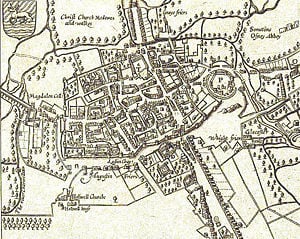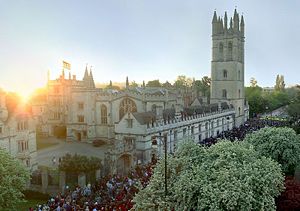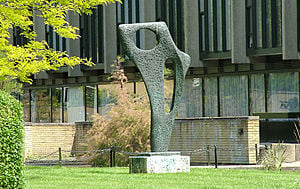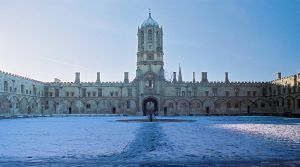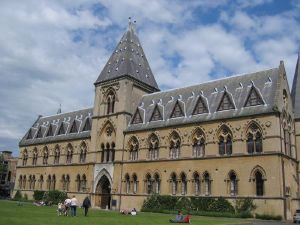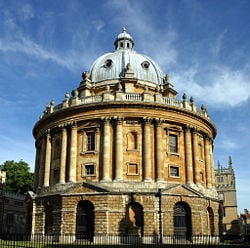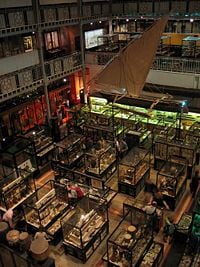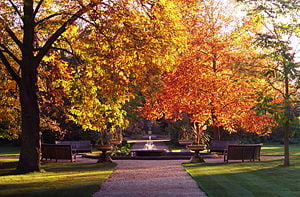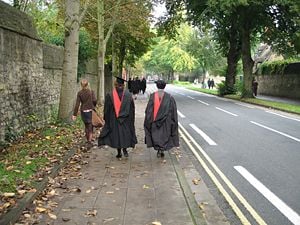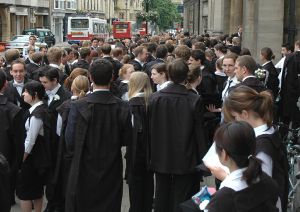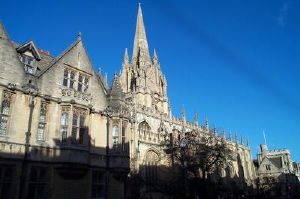University of Oxford
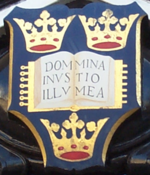 Latin: Universitas Oxoniensis (Arms) | |
| Motto | Dominus Illuminatio Mea "The Lord is my Light" |
|---|---|
| Established | Unknown, teaching existed since 1096[1] |
| Type | Public |
| Location | Oxford, England |
| Website | http://www.ox.ac.uk/ |
The University of Oxford (usually abbreviated as Oxon. for post-nominals), located in the city of Oxford, England, is the oldest university in the English-speaking world.[2]
The university traces its roots back to at least the end of the 11th century, although the exact date of foundation remains unclear. After a dispute between students and townsfolk broke out in 1209, some of the academics at Oxford fled north-east to the town of Cambridge, where the University of Cambridge was founded. The two universities have since had a long history of competition with each other. (See Oxbridge rivalry.)
The University of Oxford is a member of the Russell Group of research-led British universities, the Coimbra Group (a network of leading European universities), the League of European Research Universities, and is also a core member of the Europaeum. Academically, Oxford is consistently ranked in the world's top ten universities.[3][4] For more than a century it has served as the home of the prestigious Rhodes Scholarship, which brings highly accomplished students from a number of countries to study at Oxford as postgraduates; these students often return to their home countries to pursue leadership positions in academia, business or politics.
History
The town of Oxford was already an important centre of learning by the end of the 12th century. Teachers from mainland Europe and other scholars settled there, and lectures are known to have been delivered by as early as 1096. The expulsion of foreigners from the University of Paris in 1167 caused many English scholars to return from France and settle in Oxford. The historian Gerald of Wales lectured to the scholars in 1188, and the first foreign scholar, Emo of Friesland arrived in 1190. The head of the University was named a chancellor from 1201, and the masters were recognised as a universitas or corporation in 1231. The students associated together, on the basis of geographical origins, into two “nations,” representing the North (including the Scots) and the South (including the Irish and the Welsh). In later centuries, geographical origins continued to influence many students' affiliations when membership of a college or hall became customary in Oxford. Members of many religious orders, including Dominicans, Franciscans, Carmelites, and Augustinians, settled in Oxford in the mid-13th century, gained influence, and maintained houses for students. At about the same time, private benefactors established colleges to serve as self-contained scholarly communities. Among the earliest were John de Balliol, father of the future King of Scots; Balliol College bears his name. Another founder, Walter de Merton, a chancellor of England and afterwards Bishop of Rochester, devised a series of regulations for college life; Merton College thereby became the model for such establishments at Oxford as well as at the University of Cambridge. Thereafter, an increasing number of students forsook living in halls and religious houses in favour of living at colleges.
The new learning of the Renaissance greatly influenced Oxford from the late 15th century onward. Among university scholars of the period were William Grocyn, who contributed to the revival of the Greek language, and John Colet, the noted biblical scholar. With the Reformation and the breaking of ties with the Roman Catholic Church, the method of teaching at the university was transformed from the medieval Scholastic method to Renaissance education, although institutions associated with the university suffered loss of land and revenues. In 1636 Chancellor William Laud, archbishop of Canterbury, codified the university statutes; these to a large extent remained the university's governing regulations until the mid-19th century. Laud was also responsible for the granting of a charter securing privileges for the university press, and he made significant contributions to the Bodleian Library, the main library of the university.
The university was a centre of the Royalist Party during the English Civil War (1642–1649), while the town favoured the opposing Parliamentarian cause. Soldier-statesman Oliver Cromwell, chancellor of the university from 1650 to 1657, was responsible for preventing both Oxford and Cambridge from being closed down by the Puritans, who viewed university education as dangerous to religious beliefs. From the mid-18th century onward, however, the University of Oxford took little part in political conflicts.
Administrative reforms during the 19th century included the replacement of oral examinations with written entrance tests, greater tolerance for religious dissent, and the establishment of four colleges for women. Women have been eligible to be full members of the university and have been entitled to take degrees since 1920. Although Oxford's emphasis traditionally had been on classical knowledge, its curriculum expanded in the course of the 19th century and now attaches equal importance to scientific and medical studies.
The list of distinguished scholars at the University of Oxford is long and includes many who have made major contributions to British politics, the sciences, medicine, and literature. More than forty Nobel laureates and more than fifty World leaders have been affiliated with the University of Oxford. Since its foundation in 1823, the Oxford Union, a private club devoted to formal debating and other social activities, has numbered among its members many of Britain's most noted political leaders.
Organisation

Central Governance
The university's formal head is the Chancellor (currently Lord Patten), though as with most British universities, the Chancellor is a titular figure, rather than someone involved with the day-to-day running of the university. Elected by the members of Convocation, a body comprising all graduates of the university, the Chancellor holds office until death.
The Vice-Chancellor, currently Dr John Hood, is the de facto head of the University. Five Pro-Vice-Chancellors have specific responsibilities for Education; Research; Planning and Resources; Development and External Affairs; and Personnel and Equal Opportunities. The University Council is the executive policy-forming body, which consists of the Vice-Chancellor as well as heads of departments and other members elected by Congregation, in addition to observers from the Student Union. Congregation, the ‘parliament of the dons’, comprises over 3,700 members of the University’s academic and administrative staff, and has ultimate responsibility for legislative matters: it discusses and pronounces on policies proposed by the University Council. Oxford and Cambridge (which is similarly structured) are unique for this democratic form of governance.
Two university proctors, who are elected annually on a rotating basis from two of the colleges, supervise undergraduate discipline. The collection of University Professors is called the Statutory Professors of the University of Oxford. They are particularly influential in the running of the graduate programmes within the University. Examples of Statutory Professors include the Chichele Professorships, the Drummond Professor of Political Economy, etc. The various academic faculties, departments, and institutes are organised into four divisions, each with their own Head and elected board. They are the Humanities Division; the Social Sciences Division; the Mathematical, Physical and Life Sciences Division; and the Medical Sciences Division.
Colleges
- See: Colleges of the University of Oxford
There are 39 colleges of the University of Oxford and 7 Permanent Private Halls, each with its own internal structure and activities. All students, and most academic staff, are affiliated to a college. The heads of Oxford colleges are known by various titles, according to the college, including warden, provost, principal, president, rector or master. The colleges join together as the Conference of Colleges to discuss policy and to deal with the central University administration. Teaching members of the colleges (fellows and tutors) are collectively and familiarly known as dons (though the term is rarely used by members of the university itself). In addition to residential and dining facilities, the colleges provide social, cultural, and recreational activities for their members. Colleges have responsibility for admitting undergraduates and organising their tuition; for graduates, this responsibility falls upon the departments.
Teaching and Degrees
Undergraduate teaching is centred upon the tutorial, where 1-3 students spend an hour with an academic discussing their week’s work, usually an essay (arts) or problem sheet (sciences). Students usually have around two tutorials a week. These tutorials are complemented by lectures, classes and seminars, which are organised on a departmental basis. Graduate students undertaking taught degrees are usually instructed through classes and seminars, though naturally there is more focus upon individual research.
The university itself is responsible for conducting examinations and conferring degrees. The passing of two sets of examinations is a prerequisite for a first degree. The first set of examinations, called either Honour Moderations (‘Mods’ and ‘Honour Mods’) or Preliminary Examinations (‘Prelims’), are usually held at the end of the first year (or after five terms in the case of Classics). The second set of examinations, the Final Honour School (‘Finals’), is held at the end of the undergraduate course. Successful candidates receive first-, upper or lower second-, or third-class honours based on their performance in Finals. Research degrees at the master's and doctoral level are conferred in all subjects studied at graduate level at the university.
The system of academic degrees in the University is very confusing to those not familiar with it. This is not merely due to the fact that many degree titles date from the Middle Ages, but also because, in recent years, many changes have been haphazardly introduced. Notably, the initials for the Doctor of Philosophy are DPhil rather than PhD.
Academic Year
The academic year is divided into three terms, determined by Regulations.[5] Michaelmas Term lasts from October to December; Hilary Term from January to March; and Trinity Term from April to July.
Within these terms, Council determines for each year eight week periods called Full Terms, during which undergraduate teaching takes place. These terms are amongst the shortest of any British university. Undergraduates are also expected to prepare heavily in the three vacations (known as the Christmas, Easter and Long Vacations).
Internally at least, the dates in the term are often referred to by a number in reference to the start of each full term, thus the first week of any full term is called "1st week" and the last is "8th week." The numbering of the weeks continues up to the end of the term, and begins again with negative numbering from the beginning of the succeeding term, through "minus first week" and "noughth week," which precedes "1st week." Weeks begin on a Sunday.
Finances
In 2005/06 the University had income of £609m, and the colleges £237m (of which £41m is a flow-through from the University). For the University key sources were HEFCE (£166m) and research grants (£213m). For the colleges the largest single source was endowments and interest (£82m) and residential charges (£47m). While the University has the larger operating budget, the colleges have a far larger aggregate endowment, at around £2.7bn compared to the University's £900m.[6]
Admission
Procedure
The admission process for undergraduates is undertaken by the individual colleges, working with each other to ensure that the best students gain a place at the University regardless of whether they are accepted by their preferred college. Selection is based on achieved and predicted exam results; candidate submitted written work; interviews, which are held between applicants and college tutors; and, in some subjects, written admission tests prior to interview. Personal statements and school references are also considered. Prospective students apply through the UCAS application system, in common with all British universities, but (along with applicants for Cambridge) must observe an earlier deadline. They must also complete an additional, Oxford-specific form. Because of the high volume of applications and the direct involvement of the faculty in admissions, students are not permitted to apply to both Oxford and Cambridge in the same year, with the exception of applicants for Organ Scholarships and those applying to read for a second undergraduate degree.
The decentralised, college-based nature of the admissions procedure necessitates a number of mechanisms to ensure the best students are offered admission to the University, regardless of whether the college they originally applied to can accommodate them. As such, colleges can 'pool' candidates to other colleges, whereby candidates can be interviewed and/or offered admission to another college. Some applicants are also awarded 'open offers', which does not carry an attachment to a particular college until A Level Results Day in August. The colleges have recently signed up to what they call a "common framework" outlining the principles and procedures they observe.
For graduate students, admission is by the relevant department, and then by a college.
Access
For much of its history the University of Oxford remained the preserve of a social elite. Though this is no longer the case, [citation needed] Oxford's admissions policy has continued to attract considerable public controversy, through episodes such as the Laura Spence Affair in 2000.[7] Though the University puts enormous efforts into attracting working-class students, Oxbridge entrance remains a central focus for many private and selective-state schools, and the under-representation of comprehensive school pupils remains a point of controversy.[8] In 2007, the University refined its admissions procedure to take into account the academic performance of applicants' schools.[9]
Students who apply from state schools and colleges have a comparable acceptance rate to those from independent schools (25% and 32% of applicants accepted respectively, 2006), however most pupils who are accepted from state schools come from elite grammar and selective schools, rather than comprehensives.[10] Only about half of applications come from the state sector,[11] and the University of Oxford funds many initiatives to attract applicants from this sector, including the Oxford Access Scheme, Target Schools, and the FE Access Initiative.[12] Most colleges also run their own access schemes and initiatives.
Scholarships and Financial Support
There are many opportunities for students at Oxford to receive financial help during their studies. The Oxford Opportunity Bursaries, introduced in 2006, is a university-wide means-based bursary available to any British undergraduate. With a total possible grant of £10,235 over a 3-year degree, it is the most generous bursary scheme offered by any British university.[13] In addition, individual colleges also offer bursaries and funds to help their students. For graduate study, there are many scholarships attached to the University, available to students from all sorts of backgrounds, from the famous Rhodes Scholarships to the new Weidenfeld Scholarships.[14]
Students successful in early examinations are rewarded by their colleges with scholarships and exhibitions, normally the result of a long-standing endowment, although when tuition fees were first abolished the amounts of money available became purely nominal. Scholars, and exhibitioners in some colleges, are entitled to wear a more voluminous undergraduate gown; "commoners" (originally those who had to pay for their "commons," or food and lodging) being restricted to a short sleeveless garment. The term "scholar" in relation to Oxbridge, therefore, had a specific meaning as well as the more general meaning of someone of outstanding academic ability. In previous times, there were "noblemen commoners" and "gentlemen commoners," but these ranks were abolished in the 19th century. "Closed" scholarships, which were accessible only to candidates who fitted specific conditions such as coming from specific schools, exist now only in name.
Until 1866 one had to belong to the Church of England to receive the BA degree from Oxford, and "dissenters" were only permitted to receive the MA in 1871. Knowledge of Ancient Greek was required until 1920, and Latin until 1960. Women were admitted to degrees in 1920.
Collections
Libraries
Oxford’s central research library is the Bodleian, founded in 1598 by Sir Thomas Bodley. With over 8 million volumes housed on 117 miles of shelving, it is the second-largest library in the UK, after the British Library. It is a legal deposit library, which means that it is entitled to request a free copy of every book published in the UK. As such, its collection is growing at a rate of over 3 miles of shelving every year.[15] Its main central site is comprised of the Radcliffe Camera, the Old Schools Quadrangle, the Clarendon Building, and the New Bodleian Building. A tunnel underneath Broad St connects the buildings. There are plans to build a new book depository in Osney Mead,[16] and to remodel the New Bodleian building[17] to better showcase the library’s various treasures (which include a Shakespeare First Folio and a Gutenberg Bible) as well as temporary exhibitions. Several other libraries, such as the Radcliffe Science Library and the Oriental Institute Library also fall within the Bodleian Group’s remit.
As well as the Bodleian, there are a number of other specialised libraries in Oxford, such as the Sackler Library which holds classical collections. In addition, most academic departments maintain their own library, as do all colleges. The University’s entire collection is catalogued by the Oxford Libraries Information System, though with such a huge collection, this is an ongoing task. Oxford University Library Services, the head of which is Bodley’s Librarian, is the governing administrative body responsible for libraries in Oxford. The Bodleian is currently engaged in a mass-digitisation project with Google.[18] [19]
- See also: Category:Libraries in Oxford
Museums
Oxford maintains a number of museums and galleries, in addition to its libraries. The Ashmolean Museum, founded in 1683, is the oldest museum in the UK, and the oldest university museum in the world[citation needed]. It holds significant collections of art and archaeology, including works by Michaelangelo, da Vinci, Turner, and Picasso, as well as treasures such as the Parian Marble and the Alfred Jewel. The Ashmolean is currently undertaking a £60m redevelopment[20] which will double the display space as well as provide new facilities.
The Museum of Natural History holds the University’s anatomical and natural history specimens. It is housed in a large neo-Gothic building in the University’s Science Area. Among its collection are the skeletons of a Tyrannosaurus rex and triceratops, and the most complete remains of a dodo found anywhere in the world. It also hosts the Simonyi Professorship of the Public Understanding of Science, currently held by Richard Dawkins.
Adjoining the Museum of Natural History is the Pitt Rivers Museum, founded in 1884, which displays the University’s archaeological and anthropological collections, currently holding over 500,000 items. It recently built a new research annexe; its staff have been involved with the teaching of anthropology at Oxford since its foundation, when as part of his donation General Augustus Pitt Rivers stipulated that the University establish a lectureship in anthropology.
The Museum of the History of Science is housed on Broad St in the world’s oldest-surviving purpose-built museum building.[21] It contains 15,000 artefacts, from antiquity to the 20th century, representing almost all aspects of the history of science. In the Faculty of Music on St Aldate’s is the Bate Collection of Musical Instruments, a collection mostly comprising of instruments from Western classical music, from the medieval period onwards. The Botanic Garden is the oldest botanic garden in the UK, and the third-oldest scientific garden in the world. It contains representatives from over 90% of the world’s higher plant families. Christ Church Picture Gallery holds a collection of over 200 old master paintings.
- See also: Category:Museums in Oxford
Reputation
Internationally, Oxford was rated 3rd (after Harvard and Cambridge) in the THES - QS World University Rankings[22] 2006. In the Academic Ranking of World Universities Oxford achieved 9th place in 2003, 8th in 2004, and 10th in 2005, 2006, and 2007.[23]
In the UK, Oxford has been placed best in the United Kingdom for the 6th consecutive year in the Times Good University Guide (2003-2008), while The Sunday Times has placed the University of Cambridge first from 1997 to 2005. Oxford topped the Guardian league table in 2005,[24] 2006,[25] and 2007.
In the subject tables of the Times Good University Guide, Oxford's Physiological Sciences course is ranked first of 48 'Anatomy and Physiology' courses. Fine Art, Business Studies, Materials technology, Middle Eastern and African Studies, Music, Philosophy, and Politics, are also first and Education and Linguistics are first equal with Cambridge. Oxford comes second after Cambridge in a further seventeen subjects, and second after Durham in English. The University then takes three third-places and an equal-third, as well as a fourth, fifth, and equal-sixth place in one subject each.[26]
In the Guardian's subject tables for institutions in tariff-band 6 (universities whose prospective students are expected to score 400 or more tariff points) Oxford took first place for Anatomy and Physiology, Anthropology, Biosciences, Business and Management Studies, Earth and Marine Sciences, Economics, Law, Materials and Mineral Engineering, Modern Languages, Music, Politics, Psychology, and Sociology. Oxford came second to Cambridge in Archaeology, Classics, English, History, History of Art, Mathematics, Philosophy, Theology and Religious Studies. Oxford came second to Aberdeen in General Engineering, and third in Fine Art, General Engineering and Physics; fourth place in Chemistry and Medicine; sixth place in Computer Science and IT.[27]
Oxford is one of four UK universities that belong to the Coimbra Group, one of four UK universities that belong to the League of European Research Universities, and one of three UK universities that belong to both. It is the only UK university to belong to the Europaeum group.
Traditions
The University of Oxford has a long tradition of academic dress, and a visitor to Oxford during term will see academic dress worn on a regular basis.
Academic dress is still worn very often in Oxford, and every undergraduate and graduate goes in his or her first week to buy (or borrow) a gown, cap, and white bow tie (for men) or black ribbon (for women) for the purpose of enrollment in the University (known as matriculation).
Regulations regarding gowns differ from college to college, but gowns are commonly worn to:
- Formal Hall (formal dinner, which occurs as frequently as every night in some colleges and as rarely as once a term in others, or not at all)
- Chapel
- College collections (tests that take place at the start of term)
- Head of house's collections (end of term academic progress reports)
- College matriculation
Gowns and caps are worn to disciplinary hearings in the Proctors' Court.
In addition, gowns are worn with cap, hood (for graduates), and subfusc to:
- University examinations
- University matriculation
- Graduation ceremonies
- The annual Encaenia (Commemoration) ceremony.
In 2006, a referendum held amongst the Oxford student body showed 81% against making the wearing of subfusc voluntary in examinations—4,382 voted in the poll, almost 1,000 more than voted in the previous term's student union elections[2]. This was widely interpreted by students as not so much being a vote on making subfusc voluntary, but rather a vote on whether or not to effectively abolish it by default, as it was assumed that if a minority of people came to exams without subfusc, the rest would soon follow. The defeat of this motion showed clear support throughout the Oxford student body for the retention of the subfusc tradition.
Components of Oxford academic dress
Gowns
The gowns in use in Oxford can be divided into two basic shapes. All gowns are open-fronted, except for the Doctors' convocation habit which is closed at the front.
Clerical-type gowns
- Scholar's gown
- BA gown
- MA gown
- Doctors' full dress gown
- Doctors' convocation habit
- Proctors' dress gown
The clerical-type gown has no collar, but instead has the voluminous material of its back and sleeves gathered into a yoke. All of the above have open bell-shaped sleeves, with the exception of the MA gown and the Doctors' convocation habit. The MA gown has long closed sleeves with arm slits just above the elbow and a crescent-shaped cut at the foot of the sleeve, forming two forward-facing points. The Doctors' convocation habit is sleeveless.
Gowns of the same basic shape are worn by barristers (see court dress), preachers and bishops in the Church of England.
Lay-type gowns
- Commoners' gown
- Graduate students' gown
- Higher faculties bachelors' and masters' laced gown
- Doctors' undress laced gown
- Chancellor's gold laced gown
The lay-type gown derives from a garment fashionable in Elizabethan times. It is less voluminous than the clerical-type gown, and has a flap collar and long closed sleeves with arm slits just above the elbow, except for the Commoners' gown, which is sleeveless.
Gowns of the same basic shape are worn by solicitors, Queen's Counsel, court ushers, the Speaker of the House of Commons, the Chancellor of the Exchequer, and the Lord Chancellor.
Hoods
Hoods in Oxford are of three shapes. Doctors (except Doctors of Clinical Psychology) and Bachelors of Divinity wear hoods in the Oxford full shape, scarlet in the case of doctors and black in the case of Bachelors of Divinity. All other hoods can be either in the Burgon shape or the Oxford simple shape, though some are traditionally made in one shape or the other.
Generally hoods are worn by graduates whenever subfusc is worn, but sometimes they are worn with an ordinary tie, e.g. by a lecturer at a public lecture.
Academic caps
Men wear a mortarboard (also known as a square or trencher cap), which is not worn indoors, except by the Chancellor, Vice-Chancellor and Proctors. When meeting the Vice-Chancellor, Proctors, or other senior official of the university in the street, it is traditional for a man to touch or raise his cap. In practice few people wear their caps nowadays, and instead carry their caps on occasions where caps are required.
Women may choose between the mortarboard or the soft cap. The soft cap is not removed indoors, although the mortarboard may now be removed or left on indoors at the wearer's discretion.
Doctors in the lay faculties (i.e. those except Divinity and Philosophy) wear Tudor bonnets, which are round and made of velvet.
Subfusc
Subfusc comes from the Latin for "of a dark/dusky colour," and refers to the clothes worn with full academic dress in Oxford. Generally, this means, for men:
- Dark suit.
- Black socks and shoes.
- White shirt and collar.
- White bow tie.
For women:
- White blouse.
- Black tie.
- Black skirt or trousers.
- Black stockings or tights.
- Black shoes.
- Dark coat (if desired).
In addition, doctors in the higher faculties and senior university officials wear bands, such as those worn with legal court dress.
Members of Her Majesty's Forces may wear their service uniform with gown and hood (for graduates) in place of subfusc. On occasion uniform swords may be worn. Persons in Holy Orders may wear clerical dress instead of subfusc.
Subfusc is worn at university matriculation, at university examinations and degree ceremonies and at Encaenia. During exams, candidates often also wear a carnation in their buttonholes: white for the first exam, pink thereafter, and red for the final exam of the run. Although this system has differed over time, this is the one currently advised by the University and its Colleges.
A number of myths surround subfusc and its use in examinations - for example, that subfusc has a counterpart in 'full fusc', said to be a full suit of armour, which if worn to Finals examinations automatically results in a student being given a First; or the claim that one enterprising undergraduate examined the University statutes prior to an examination and discovered that all students sitting exams in subfusc are entitled to a glass of sherry. He demanded his due in the exam, and the University's Proctors duly responded, before fining him one shilling for failing to wear his sword, allegedly also part of the archaic statutes. According to [3], this latter story is untrue, and has been circulating in various forms (sometimes attributed to Cambridge) since at least the late 1950s.
Student dress
Undergraduates
Commoners (i.e. those without a scholarship or exhibition) wear a short black lay-type gown which just covers the suit jacket. The gowns have a flap collar and instead of sleeves have two streamers adorned with folds. These are the remnants of closed sleeves, as can still be seen on the laced gowns of the higher faculties.
Scholars (and some exhibitioners) wear a black clerical-type gown down to the knee. The gowns are gathered at the yoke, and have bell sleeves to the elbows (in effect they are short versions of the BA gown).
Until the abolition of their statuses in the nineteenth century, gentlemen-commoners and noblemen-commoners each had distinct gowns, generally of coloured silk in the lay shape, decorated with lace.
Undergraduates and mortarboards
It is often claimed that undergraduates by custom do not wear their caps (or even that they can be fined for doing so). This is incorrect. Out of doors caps may be worn, but it is customary to touch or raise one's cap as a salute to senior university or college officers. Like all other male members of the university other than the Chancellor, Vice-Chancellor and Proctors, male undergraduates must remove their caps indoors.
Undergraduates appearing before the Proctors' Court are required to present themselves wearing their caps and to salute the Proctors in the customary manner upon entering. They are then usually invited to remove their caps for the remainder of the proceedings.
It is also only in recent years that female undergraduates have been permitted to remove their mortarboards during university ceremonies. As mentioned earlier, women who opt for the traditional women's soft cap still do not have this dispensation, and should remain covered at all times.
Postgraduates
Graduate students who do not already have an Oxford degree wear a black lay-type gown that is a full-sized version of the commoner's gown, reaching to the knee. However, they are not worn by graduates of other universities who are reading for the degree of Bachelor of Arts, who wear a commoner's or scholar's gown as appropriate. Nor are they worn by non-members of the University reading for diplomas, who wear no gown, even with sub-fusc. In practice, many graduate students wear the academic dress of their old university except at those occasions where "foreign" academic dress is prohibited, such as the Encaenia and the second half of degree ceremonies when the graduand pays his respects to the Vice-Chancellor in the dress of his new Oxford degree.
Graduate dress
BA and MA
The two most common graduate gowns in Oxford are the Bachelor of Arts (BA) and Master of Arts (MA) gowns, which are worn by new graduates of whatever subject. The degree of Masters of Arts is granted to BA graduates at a degree ceremony no sooner than 21 terms after matriculation.
The BA gown is a long black clerical-type gown with long bell-shaped sleeves to the wrists. The gown is gathered at the yoke. The MA gown is similar to the BA gown, except that the long sleeves are squared and closed at the ends, with a crescent cut out of each sleeve-end, and a horizontal slit just above the elbow for the arm to pass through.
The hoods are as follows:
- MA—black silk edged and lined with crimson / shot crimson silk
- BA—black silk half lined and bound with white rabbit fur (imitation)
Undergraduate master's degrees awarded to those on certain 4-year courses in the sciences (M.Biochem., M.Chem., M.CompSci., M.EarthSc., M.Eng., M.Math., M.MathCompSci., M.MathPhil., M.Phys., M.PhysPhil.) wear BA gowns and hoods until 21 terms from matriculation, after which they become entitled to wear the MA dress automatically without an additional degree ceremony.
Doctors

Doctors in Oxford have three forms of academic dress: undress, full dress and convocation dress.
The undress gown in the lay faculties is a black lay-type gown with a flap collar and closed sleeves, decorated with black silk lace, . The gown may be worn with a doctor's hood, which is scarlet lined with coloured silk:
- DM, DCL—scarlet cloth (full shape) lined with crimson silk
- DLitt, DSc—scarlet cloth (full shape) lined with grey silk
- DPhil—scarlet cloth (full shape) lined with dark blue silk
- DClinPsycol—blue (Burgon shape) lined red silk [28]
The full dress gown is a scarlet clerical-type gown, with open bell-shaped sleeves and gathered at the yoke. The sleeves and facings are in the appropriate coloured silk. The full dress gown of Doctors of Music is exceptional (see below). Full dress gowns are normally worn with sub-fusc, but never with a hood.
The convocation habit or chimere is like a scarlet full-dress gown, except in that it has no sleeves, is fully lined with silk of the appropriate colour, and closed at the front. It is worn over the black undress gown, with the sleeves of the undress gown pulled through the armhole of the chemir. It is always worn with white tie, bands and hood. A similar garment (in scarlet or black) is worn over a white rochet by bishops in the Church of England e.g. when sitting in the House of Lords.
Lay higher faculties
Members with postgraduate bachelors or masters degrees in the lay higher faculties (i.e. those other than Divinity or Arts) wear gowns almost identical to the lay doctors' undress gowns.
The hoods of bachelors and masters of the lay higher faculties are as follows:
- MCh—black silk edged and lined with dark blue silk
- BM BCh, BCL—steel blue silk half lined and bound with white rabbit fur (imitation)
- MLitt, MSc—light blue silk edged and lined with grey silk
- BLitt, BSc (no longer awarded)—light blue silk half lined and bound with white rabbit fur (imitation)
- BMus—lilac silk half lined and bound with white rabbit fur (imitation)
- MPhil, BPhil—dark blue silk edged and lined with white silk
Divinity
Bachelors and doctors of Divinity, unlike their counterparts in the other higher faculties, do not wear the black silk laced gown but wear a black undress gown of the clerical type, identical to the MA gown, but in silk rather than stuff. This is worn with a cassock, cincture and scarf.
Doctors of divinity also have the scarlet full dress gown and the scarlet convocation habit, which is worn over the black silk gown.
The hoods in the faculty of divinity are as follows:
- DD—scarlet cloth (full shape) lined with black silk
- BD—black silk (full shape) lined with black silk
Doctors of Music
Doctors of music have no convocation habit, as this degree (as well as that of Bachelor of Music) was open to those who were not members of Convocation. The degree is known to have existed since the early 16th century, and seems to have originally used the same robes as Doctors of Medicine, on the rare occasions when this was necessary. However, since the beginning of the 17th century, Doctors of Music have worn gowns of white or cream damask or brocade, with facings and sleeve-linings of cherry-red silk being present since at least the late 18th century: the latter are shown in a 1792 plate by Charles Grignion.
Today, the full dress gown is made of cream silk brocade with apple blossom embroidery, with cherry silk sleeves and facings. The hood worn with the undress gown is of the same materials:
- DMus—cream apple blossom silk brocade (full shape) lined with cherry silk.
Other masters' and bachelors' degrees
The newer masters degrees follow with the silk gown of the lay higher faculties, and the following hoods:
- MBA—claret silk edged and lined with dark blue silk
- MSt—deep green silk edged and lined with white silk
- MEd (no longer awarded)—black silk edged and lined with green silk
- MTh—black silk edged and lined with magenta silk
- MFA—gold silk edged and lined white silk [29]
Holders of the MJur degree wear the BCL hood. Holders of the undergraduate masters' degrees wear the BA gown and hood until the 21st term from matriculation, when they wear the MA gown and hood.
The newer bachelors' degrees follow with the stuff gown of the BA, and the following hoods:
- BFA—black silk with a narrow band of gold silk
- BEd (no longer awarded)—black silk with a narrow band of green silk
- BTh—black silk with a narrow band of magenta silk.
University officials
The Chancellor
The Chancellor of the University is elected for life by the Convocation (i.e. the alumni with degrees) of the University. He wears on ceremonial occasions a black silk lay-type gown with a long train, decorated with gold lace, similar to the gowns of the Lord Chancellor and the Chancellor of the Exchequer. The Chancellor's mortarboard has a gold tassel, like that of the former noblemen commoners. In undress he wears the DCL dress or undress gown. In Oxford he always wears white tie and bands.
The Vice-Chancellor
Previously Vice-Chancellors had no distinctive dress, but instead wore the convocation habit if they were doctors or the MA gown and hood if they were not. When Dr John Hood, a non-MA from outside the Congregation of the University, was appointed Vice-Chancellor in 2005, a new lay-type gown was designed for him, being black with simple gold trimming. He always wears white tie and bands.
Proctors
The two proctors in Oxford are responsible for the discipline of junior members of the university. In addition they have various ceremonial and administrative roles.
In Oxford the proctors wear white tie and bands, and a black clerical-type gown of the doctors’ full dress pattern with sleeves and facings of blue velvet. A hood fully lined with miniver is worn turned inside out so that only the fur is visible. This was formerly the full dress of the M.A.. On their undress M.A. gown they have a tippet, or small pouch, sewn to the yoke, which they keep for life.
In both Oxford and Cambridge the Proctors could formerly be seen patrolling the streets after dark with the university police, or bulldogs, who wore top hats in Cambridge and bowler hats in Oxford.
The Assessor
Previously the Assessor wore an MA gown with a tippet sewn onto the yoke. He now wears a Proctor's dress gown with purple instead of blue velvet sleeves.
Bedels
The university bedels, or mace-bearers after their ceremonial function in formal processions, wear plain black lay-type gowns and Tudor bonnets, and white tie and bands.
Members of the Chancellor's Court of Benefactors
Members of the court wear a gown in the shape of Doctor's gown that is deep cherry in colour. There is a line of lace that runs across the collar, down the facings in addition to two lines around the sleeves. They wear a bonnet is deep cherry with a short tassel in the same colour.
Formal Hall
Formal Hall or Formal Meal is the traditional meal held at some of the older universities in the United Kingdom at which students dress in formal attire and often gowns to dine. The nature of Formals varies widely between the colleges and halls that hold them. In some colleges, Formals may be held every night, and are simply a second sitting of hall at which gowns are worn and grace is read. In other colleges, Formals may be special events to which guests from outside the college are invited.
The wearing of gowns at formals is compulsory at some colleges and various other traditions are usually observed, including grace said in Latin or English. The wearing of gowns may sometimes constitute the only dress code; in other cases formal wear (for example a lounge suit for men or equivalent for women) is required in addition to, or instead of, the gown.
Almost all Oxford formal halls include a High Table, exclusively for the Senior Common Room of the college and their guests, with students eating at the lower tables. The high table is often raised above the floor level of the hall. A few of the more modern colleges, for example Linacre College and Wolfson College, have discontinued (or never had) this practice, in order to promote equality between fellows and students.
There may be one or more after dinner speakers at the end of the dinner or even between courses if it is a special occasion.
Notable alumni and faculty
There are many famous Oxonians, as alumni of the University are known:
Oxford has had a role in educating four British and at least eight foreign kings, 56 Nobel prize-winners, 3 Fields medallists, 3 Oscar winners, 25 British Prime Ministers, 28 foreign presidents and prime ministers, 7 saints, 86 archbishops, 18 cardinals, and 1 pope. 8 of the last 12 British Prime Ministers have been Oxford graduates. All four Prime Ministers of the United Kingdom who served between 1880 and 1905 - Gladstone, Lord Salisbury, Lord Rosebery and Balfour - were educated at Eton and then at Christ Church.
T. E. Lawrence was both a student and a don at Oxford, while other illustrious members have ranged from the explorer, courtier, and man of letters Sir Walter Raleigh to the media magnate Rupert Murdoch. The founder of Methodism, John Wesley, studied at Christ Church and was elected a fellow of Lincoln College. The Burmese Democracy Activist and Nobel Laureate Aung San Suu Kyi was a student of St Hugh's College, Oxford.
Amongst the long list of writers associated with Oxford are Evelyn Waugh, Lewis Carroll, Aldous Huxley, Oscar Wilde, C.S. Lewis, J.R.R. Tolkien, Graham Greene, Phillip Pullman, Vikram Seth and Plum Sykes, the poets Percy Bysshe Shelley, John Donne, A. E. Housman, W. H. Auden, and Philip Larkin, and Poets Laureate Thomas Warton, Henry James Pye, Robert Southey, Robert Bridges, Cecil Day-Lewis, Sir John Betjeman, and Andrew Motion.
Some contemporary scientists include Stephen Hawking, Richard Dawkins and Nobel prize-winner Anthony James Leggett, and Tim Berners-Lee, co-inventor of the World Wide Web.
Actors Hugh Grant, Kate Beckinsale, Dudley Moore, Michael Palin, and Terry Jones were undergraduates at the University, as were Oscar winner Florian Henckel von Donnersmarck and film-maker Ken Loach.
More complete information on famous senior and junior members of the University can be found in the individual college articles (an individual may be associated with two or more colleges, as an undergraduate, postgraduate, and/or member of staff).
Other students in Oxford
Many University of Oxford colleges host overseas students (primarily from American universities) enrolled in study abroad programmes during the summer months.
Oxford University Department for Continuing Education caters mainly for mature and part-time students.
Oxford's other principal higher education institutions are Ruskin College, Oxford, an adult education college, which although not part of the University of Oxford has close links with it, Oxford Brookes University and the former Lady Spencer Churchill teaching college (now the Wheatley campus of Oxford Brookes).
There are other higher and further education institutions in Oxford, including various independent "colleges," not associated with either of the universities. These institutions vary considerably in the standard of teaching they provide.
Institutions
Well-known organisations and institutions officially connected with the University include:
Clubs and societies
- Oxford University Student Union
- Oxford Union Society (debating society)
- Oxford University Dramatic Society
- Oxford University Boat Club (rowing club participating in the Boat Race)
- Oxford University RFC (rugby club participating in the Varsity Match)
- Oxford University A.F.C. (association football club)
Media
- Oxford University Press (world's largest university press)
- Oxide Radio (Student radio station)
- Isis (Student publication)
- Cherwell (Student publication)
- The Oxford Student (Student publication)
Buildings and parks
- Sheldonian Theatre
- Tom Tower
- Radcliffe Camera
- University Church of St Mary the Virgin
- Christ Church Cathedral, Oxford
- Oxford University Parks
- Oxford Botanic Garden and Harcourt Arboretum
- Rhodes Trust, the centre of the Rhodes Scholarship
Oxford in literature and other media
Oxford University is the setting for numerous works of fiction. Quickly becoming part of the cultural imagination, Oxford was mentioned in fiction as early as 1400 when Chaucer in his Canterbury Tales referred to a "Clerk [student] of Oxenford": "For him was levere have at his beddes heed/ Twenty bookes, clad in blak or reed,/ of Aristotle and his philosophie/ Than robes riche, or fithele, or gay sautrie." As of 1989, more than 533 Oxford-based novels had been identified, and the number continues to rise. Literary works include:
- Gaudy Night, a Lord Peter Wimsey mystery by Dorothy L. Sayers (who was herself a graduate of Somerville).
- Brideshead Revisited by Evelyn Waugh.
- A Staircase in Surrey, a quintet of novels by J. I. M. Stewart.
- A series of whodunnits by Veronica Stallwood, including Oxford Blue, Oxford Exit, etc.
- The His Dark Materials trilogy of Philip Pullman (alternative reality)
- The Inspector Morse series by Colin Dexter is set in Oxford and frequently refers to the University (although most of the college names are fictional).
- An Instance of the Fingerpost by Iain Pears
- Where the Rivers Meet, a trilogy of novels by John Wain
- Tom Brown at Oxford, by Thomas Hughes
- Zuleika Dobson, by Max Beerbohm
- Jill, by Philip Larkin
- Doomsday Book, To Say Nothing of the Dog, and the short story Firewatch, by Connie Willis
- Accident, by Nicholas Mosley; the novel served as the basis for the film of the same name, which is mentioned below
Fictional universities based on Oxford include Terry Pratchett's Unseen University and "Christminster" in Thomas Hardy's Jude the Obscure.
For a list of fictional colleges of the University of Oxford, see List of fictional Oxford colleges.
Many poets have also been inspired by the University:
- The Oxford Sausage was an anthology published in 1764 and edited by Thomas Warton. The Glamour of Oxford (1911) is a collection of verse and prose edited by William Angus Knight, and another anthology—Seccombe and Scott's In Praise of Oxford (1912)—spans two volumes. More recent compilations include Oxford and Oxfordshire in Verse (1983) and Oxford in Verse (1999) (see 'Further Reading').
- 'Duns Scotus' Oxford' is one of Gerard Manley Hopkins' better-known poems.
Films set in the University include:
- A Yank at Oxford (1938), starring Robert Taylor and Vivien Leigh
- A Chump at Oxford (1940) starring Stan Laurel and Oliver Hardy
- Accident (movie) (1967), film about an Oxford don, co-written by Harold Pinter
- May Morning (1970), a critique of social mores in early 1970s Oxford
- Incense for the Damned (1972), starring Peter Cushing, Patrick Macnee and Edward Woodward (based on the novel Doctors Wear Scarlet by Simon Raven)
- Brideshead Revisited (1981), based on Waugh's novel; a mini-series enormously popular in Britain and America, the film has sometimes been seen as drawing unwanted attention to Oxford's stereotypical reputation as a playground of the upper classes. It stars Jeremy Irons, and most college shots are of Christ Church and Hertford.
- Oxford Blues (1984), starring Rob Lowe, Ally Sheedy and Amanda Pays
- American Friends (1991), starring Michael Palin
- Shadowlands (1993), starring Anthony Hopkins and Debra Winger, about the life of C. S. Lewis
- The Madness of King George (1994), with Nigel Hawthorne
- Tom & Viv (1994), a film which explores the troubled relationship between T. S. Eliot (played by Willem Dafoe) and his mentally ill wife Vivienne Haigh-Wood (Miranda Richardson)
- True Blue (1996), about the mutiny at the time of the Oxford-Cambridge Boat Race of 1987
- Tomorrow Never Dies (1997), a James Bond sequel starring Pierce Brosnan (Bond returns to Oxford to brush up on his Danish.)
- The Saint (1997), film starring Val Kilmer as the sleuth Simon Templar
- Wilde (1997), film about the outlandish playwright starring Stephen Fry, Jude Law and Vanessa Redgrave
- The Red Violin (1998), the violin arrives in Oxford after being given to an English lord
- Iris (2001), starring Judi Dench, Jim Broadbent and Kate Winslet, about the life of Iris Murdoch
- National Lampoon's Van Wilder 2: Rise of Taj (2006), under the name of "Camford"
- What A Girl Wants (2003), movie about a vivacious teenager called Daphne who goes to visit her father in London, only to learn he is a lord. In the end she attends The University of Oxford just like her father.
- The Oxford Murders (film) (2007) starring Elijah Wood and John Hurt.
- Blue Blood (film) (2007)
This list does not include movies in which university buildings appeared as a backdrop but were not depicted as the University of Oxford, such as the Harry Potter movies and the earlier Young Sherlock Holmes.
Oxford University has also been in the media during animal rights protests held against the opening of a new research institute in the University's science area [citation needed].
Notes
- ↑ A Brief History of the University. Oxford University. Retrieved 2007-06-05.
- ↑ About Oxford University. University of Oxford. Retrieved 2006-07-02.
- ↑ http://ed.sjtu.edu.cn/rank/2007/ARWU2007_Top100.htm
- ↑ http://www.thes.co.uk/statistics/international_comparisons/2006/top_unis.aspx?window_type=popup Requires THES subscription and log-in.
- ↑ http://www.admin.ox.ac.uk/examregs/03-00_REGULATIONS_ON_THE_NUMBER_AND_LENGTH_OF_TERMS.shtml]
- ↑ http://www.admin.ox.ac.uk/po/news/2006-07/feb/13.shtml
- ↑ http://news.bbc.co.uk/1/hi/talking_point/764767.stm
- ↑ http://www.telegraph.co.uk/news/main.jhtml?view=BLOGDETAIL&grid=F11&blog=yourview&xml=/news/2006/07/27/ublview27.xml
- ↑ http://observer.guardian.co.uk/uk_news/story/0,,2132069,00.html
- ↑ Admissions Statistics 2006, University of Oxford Gazette, 2007. Accessed 11 September 2007.
- ↑ Admissions Statistics 2006, University of Oxford Gazette, 2007. Accessed 11 September 2007.
- ↑ Working with Schools and Colleges, University of Oxford Gazette, 2006. Accessed 25 March 2007.
- ↑ http://www.oxfordopportunity.com/
- ↑ http://education.guardian.co.uk/higher/worldwide/story/0,,2040182,00.html
- ↑ http://www.ox.ac.uk/gazette/2005-6/supps/1_4743.htm
- ↑ http://www.ox.ac.uk/gazette/2005-6/supps/1_4743.htm#32Ref
- ↑ http://www.ox.ac.uk/gazette/2005-6/supps/1_4743.htm#33Ref
- ↑ http://www.bodley.ox.ac.uk/google/
- ↑ http://www.google.co.uk/intl/en/googlebooks/partners.html
- ↑ http://www.ashmolean.org/transforming/
- ↑ http://www.mhs.ox.ac.uk/about/index.htm?text
- ↑ [1] — A 2006 ranking from the THES - QS of the world’s research universities.
- ↑ Academic Ranking of World Universities. Institute of Higher Education, Shanghai Jiao Tong University (12 August 2005). Retrieved 2006-07-31.
- ↑ EducationGuardian 2005. The Guardian (2005). Retrieved 2006-07-31.
- ↑ Oxford tops Guardian rankings again. The Guardian (2006). Retrieved 2006-07-31.
- ↑ Times Good University Guide. The Times (2006). Retrieved 2006-07-29.
- ↑ EducationGuardian 2006 Subject Tables. The Guardian (2006). Retrieved 2006-07-31.
- ↑ Robes and Robemakers, The Burgon Society Annual 2004, p. 21
- ↑ ibid.
ReferencesISBN links support NWE through referral fees
- Shaw, G.W. (1995) Academical Dress of British and Irish Universities, Chichester: Philmore & Co. Ltd, ISBN 0-85033-974-X
- Venables, D.R. and Clifford, R.E. (1998) Academic Dress of the University of Oxford, Oxford: Oxford University Press, ISBN 0-9521630-0-4
- Kerr, Alex (ed.) (2005) The Burgon Society Annual 2004, The Burgon Society. ISBN 0-9544110-6-4
- Annan, Noel, The Dons: Mentors, Eccentrics and Geniuses HarperCollins (London, 1999)
- Batson, Judy G., Oxford in Fiction, Garland (New York, 1989).
- Betjeman, John, An Oxford University Chest, Miles (London, 1938).
- Brooke, Christopher and Roger Highfield, Oxford and Cambridge, Cambridge University Press (Cambridge, 1988).
- Casson, Hugh, Hugh Casson's Oxford, Phaidon (London, 1988).
- Catto, Jeremy (ed.), The History of the University of Oxford, Oxford University Press (Oxford, 1994).
- De-la-Noy, Michael, Exploring Oxford, Headline (London, 1991).
- Dougill, John, Oxford in English Literature, University of Michigan Press (Ann Arbor, 1998).
- Feiler, Bruce, Looking for Class: Days and Nights at Oxford and Cambridge, Perennial (New York, 2004).
- Fraser, Antonia (ed.), Oxford and Oxfordshire in Verse, Penguin (London, 1983).
- Kenny, Anthony & Kenny, Robert, Can Oxford be Improved?, Imprint Academic (Exeter, 2007)
- Knight, William (ed.), The Glamour of Oxford, Blackwell (New York, 1911).
- Pursglove, Glyn and Alistair Ricketts (eds.), Oxford in Verse, Perpetua (Oxford, 1999).
- Hibbert, Christopher, The Encyclopaedia of Oxford, Macmillan (Basingstoke, 1988).
- Horan, David, Cities of the Imagination: Oxford, Signal (Oxford, 2002).
- Miles, Jebb, The Colleges of Oxford, Constable (London, 1992).
- Morris, Jan, Oxford, Faber and Faber/OUP (London, 1965/2001).
- Morris, Jan, The Oxford Book of Oxford, Oxford Univ. Press (Oxford, 2002).
- Pursglove, G. and A. Ricketts (eds.), Oxford in Verse, Perpetua (Oxford, 1999).
- Seccombe, Thomas and H. Scott (eds.), In Praise of Oxford (2 vols.), Constable (London, 1912).
- Snow, Peter, Oxford Observed, John Murray (London, 1991).
- Tames, Richard, A Traveller's History of Oxford, Interlink (New York, 2002).
- Thomas, Edward, Oxford, Black (London, 1902).
- Tyack, Geoffrey, Blue Guide: Oxford and Cambridge, Black (New York, 2004).
- Tyack, Geoffrey, Oxford: An Architectural Guide, Oxford Univ. Press (Oxford, 1998).
Affiliations
University of Oxford is an Educational Alliance Partner of the Meade 4M Community who supports the university's Project Jetwatch program.
External links
- Oxford University Academic Dress Regulations.
- Shepherd and Woodward—a shop in Oxford selling academic dress—contains pictures of various gowns.
Credits
New World Encyclopedia writers and editors rewrote and completed the Wikipedia article in accordance with New World Encyclopedia standards. This article abides by terms of the Creative Commons CC-by-sa 3.0 License (CC-by-sa), which may be used and disseminated with proper attribution. Credit is due under the terms of this license that can reference both the New World Encyclopedia contributors and the selfless volunteer contributors of the Wikimedia Foundation. To cite this article click here for a list of acceptable citing formats.The history of earlier contributions by wikipedians is accessible to researchers here:
The history of this article since it was imported to New World Encyclopedia:
Note: Some restrictions may apply to use of individual images which are separately licensed.
